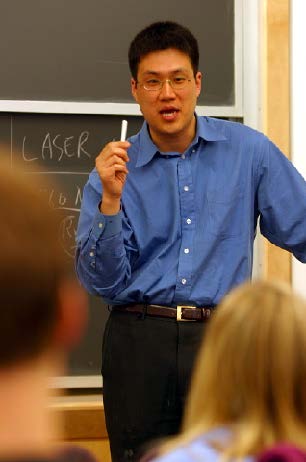2016 Lecture: From ultraslow plasmons to ultrafast drug discovery - Professor Donhee Ham, Harvard University
Published: 12 September 2016
Date: Friday, 7th October 2016, 16:30-17:30 Venue: Room 408 (LT), Rankine Building
Professor Donhee Ham, Gordon McKay Professor of Applied Physics and EE at Harvard University, will be visiting the School of Engineering. As part of his visit he will deliver the Electronic Systems Design Centre Autumn Lecture entitled, "From ultraslow plasmons to ultrafast drug discovery". Abstract and biography are given below.
Date & Time: 16:30, Friday, 7th October
Venue: Room 408 (LT), Rankine Building
Register to attend here
Abstract
We develop solid-state devices and circuits for applications in EE, biology, and physics. I will highlight these efforts with selected recent works:
(1) Dimensionality profoundly influences condensed-matter electron behaviors, with 2D conductors enabling discoveries of intriguing fundamental phenomena. One great effect of this reduced dimensionality concerns ultraslow plasmons. We obtained 2D plasmons 700× slower than free-space light. These ultraslow plasmons open up new exciting vistas for light manipulation, light-matter interaction, and bandgap-less gain. I will present a host of 2D plasmonic circuits that manipulate light in a broad variety of ways, and discuss 2D plasmonics experiments to measure the mass of massless graphene electrons and to obtain bandgap-less plasmonic gain.
(2) NMR spectroscopy that can elucidate structure and function of biomolecules at atomic resolution is a paramount analytical tool in biology and medicine and has proven enormously fruitful in pharmaceutical screening, structural biology, and metabolomics. But it suffers critically from inherently low throughput. I will share our program to develop a massively parallel––thus ultrahigh throughput––biomolecular NMR paradigm by exploiting silicon chip technology, and its applications in structural biology, drug discovery, and metabolomics.
(3) Another biotech work is to create, in collaboration with Prof. Hongkun Park, CMOS-assisted vertical nanowire arrays as a new neurotechnology tool that parallelizes intracellular access into neurons. Experimentations with this nano-bio interface will be discussed together with its applications in neurobiology, implanted technology, and brain machine interface.
Biography
Donhee Ham is Gordon McKay Professor of Applied Physics and EE at Harvard. He earned a B.S. in physics from Seoul National Univ., graduating atop the College of Natural Sciences with Presidential Prize and Physics Gold Medal. Following a military service in Korea, he went to Caltech for graduate training in physics; he worked on relativistic astrophysics while in physics, and later obtained a Ph.D. in EE winning the Charles Wilts best thesis award. His doctoral work examined the statistical physics of electrical circuits. He was the recipient of the IBM Doctoral Fellowship, Li Ming Scholarship, IBM Faculty Partnership Award, IBM Research Design Challenge Award, and Korea Foundation of Advanced Studies Fellowship. He was recognized by MIT Technology Review as among the top 35 young innovators in 2008 (TR35). He was a 4-time Harvard Yearbook Favorite Professor (2011-2014), and among 8 Harvard Thinks Big speakers in 2012 chosen by college-wide votes. Other experiences include LIGO, IBM Watson Research, consulting visiting professorship at POSTECH, distinguished visiting professorship at Seoul National Univ., TPCs in IEEE ISSCC and IEEE ASSCC, advisory board for IEEE ISCAS, guest editorship for IEEE JSSC, IEEE SSC Distinguished Lecturer, and associate editorship for IEEE Tbiocas.
First published: 12 September 2016
<< CAE Lectures


